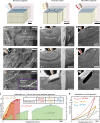Nanoscale deformation mechanics reveal resilience in nacre of Pinna nobilis shell
- PMID: 31645557
- PMCID: PMC6811596
- DOI: 10.1038/s41467-019-12743-z
Nanoscale deformation mechanics reveal resilience in nacre of Pinna nobilis shell
Abstract
The combination of soft nanoscale organic components with inorganic nanograins hierarchically designed by natural organisms results in highly ductile structural materials that can withstand mechanical impact and exhibit high resilience on the macro- and nano-scale. Our investigation of nacre deformation reveals the underlying nanomechanics that govern the structural resilience and absorption of mechanical energy. Using high-resolution scanning/transmission electron microscopy (S/TEM) combined with in situ indentation, we observe nanoscale recovery of heavily deformed nacre that restores its mechanical strength on external stimuli up to 80% of its yield strength. Under compression, nacre undergoes deformation of nanograins and non-destructive locking across organic interfaces such that adjacent inorganic tablets structurally join. The locked tablets respond to strain as a continuous material, yet the organic boundaries between them still restrict crack propagation. Remarkably, the completely locked interface recovers its original morphology without any noticeable deformation after compressive contact stresses as large as 1.2 GPa.
Conflict of interest statement
The authors declare no competing interests.
Figures




Similar articles
-
In situ observation of nanograin rotation and deformation in nacre.Nano Lett. 2006 Oct;6(10):2301-4. doi: 10.1021/nl061775u. Nano Lett. 2006. PMID: 17034101
-
Nanoscale assembly processes revealed in the nacroprismatic transition zone of Pinna nobilis mollusc shells.Nat Commun. 2015 Dec 3;6:10097. doi: 10.1038/ncomms10097. Nat Commun. 2015. PMID: 26631940 Free PMC article.
-
Orientation-dependent micromechanical behavior of nacre: In situ TEM experiments and finite element simulations.Acta Biomater. 2022 Jul 15;147:120-128. doi: 10.1016/j.actbio.2022.05.033. Epub 2022 May 21. Acta Biomater. 2022. PMID: 35609803
-
Bioinspired layered materials with superior mechanical performance.Acc Chem Res. 2014 Apr 15;47(4):1256-66. doi: 10.1021/ar400279t. Epub 2014 Mar 17. Acc Chem Res. 2014. PMID: 24635413 Review.
-
The toughening mechanism of nacre and structural materials inspired by nacre.Sci Technol Adv Mater. 2012 Jan 26;12(6):064710. doi: 10.1088/1468-6996/12/6/064710. eCollection 2011 Dec. Sci Technol Adv Mater. 2012. PMID: 27877460 Free PMC article. Review.
Cited by
-
Exploring the Potential of Nonclassical Crystallization Pathways to Advance Cementitious Materials.Chem Rev. 2024 Jun 26;124(12):7538-7618. doi: 10.1021/acs.chemrev.3c00259. Epub 2024 Jun 14. Chem Rev. 2024. PMID: 38874016 Free PMC article. Review.
-
Organization and Formation of the Crossed-Foliated Biomineral Microstructure of Limpet Shells.ACS Biomater Sci Eng. 2023 Dec 11;9(12):6658-6669. doi: 10.1021/acsbiomaterials.3c00928. Epub 2023 Nov 22. ACS Biomater Sci Eng. 2023. PMID: 37991876 Free PMC article.
-
Nanograded artificial nacre with efficient energy dissipation.Innovation (Camb). 2023 Aug 30;4(6):100505. doi: 10.1016/j.xinn.2023.100505. eCollection 2023 Nov 13. Innovation (Camb). 2023. PMID: 37744177 Free PMC article.
-
Design principles in mechanically adaptable biomaterials for repairing annulus fibrosus rupture: A review.Bioact Mater. 2023 Sep 4;31:422-439. doi: 10.1016/j.bioactmat.2023.08.012. eCollection 2024 Jan. Bioact Mater. 2023. PMID: 37692911 Free PMC article. Review.
-
Biomimetic Nacre-like Hydroxyapatite/Polymer Composites for Bone Implants.J Funct Biomater. 2023 Jul 25;14(8):393. doi: 10.3390/jfb14080393. J Funct Biomater. 2023. PMID: 37623638 Free PMC article.
References
-
- Espinosa HD, Rim JE, Barthelat F, Buehler MJ. Merger of structure and material in nacre and bone – perspectives on de novo biomimetic materials. Prog. Mater. Sci. 2009;54:1059–1100. doi: 10.1016/j.pmatsci.2009.05.001. - DOI
Publication types
MeSH terms
Substances
LinkOut - more resources
Full Text Sources
Other Literature Sources


